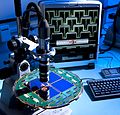Dosiero:PIA17993-DetectorsForInfantUniverseStudies-20140317.jpg

Grandeco de ĉi antaŭvido: 624 × 600 rastrumeroj. Aliaj distingivoj: 250 × 240 rastrumeroj | 499 × 480 rastrumeroj | 799 × 768 rastrumeroj | 1 065 × 1 024 rastrumeroj | 2 130 × 2 048 rastrumeroj | 3 000 × 2 884 rastrumeroj.
Bildo en pli alta difino ((3 000 × 2 884 rastrumeroj, grandeco de dosiero: 842 KB, MIME-tipo: image/jpeg))
Dosierhistorio
Alklaku iun daton kaj horon por vidi kiel la dosiero tiam aspektis.
| Dato/Horo | Bildeto | Grandecoj | Uzanto | Komento | |
|---|---|---|---|---|---|
| nun | 21:13, 17 mar. 2014 |  | 3 000 × 2 884 (842 KB) | Drbogdan | User created page with UploadWizard |
Dosiera uzado
Neniu paĝo ligas al ĉi tiu dosiero.
Suma uzado de la dosiero
La jenaj aliaj vikioj utiligas ĉi tiun dosieron:
- Uzado en an.wikipedia.org
- Uzado en ar.wikipedia.org
- Uzado en az.wikipedia.org
- Uzado en de.wikipedia.org
- Uzado en en.wikipedia.org
- Uzado en fa.wikipedia.org
- Uzado en fr.wikipedia.org
- Uzado en gl.wikipedia.org
- Uzado en he.wikipedia.org
- Uzado en hy.wikipedia.org
- Uzado en it.wikipedia.org
- Uzado en ka.wikipedia.org
- Uzado en ko.wikipedia.org
- Uzado en mk.wikipedia.org
- Uzado en nn.wikipedia.org
- Uzado en pl.wikipedia.org
- Uzado en pl.wikinews.org
- Uzado en pt.wikipedia.org
- Uzado en ru.wikipedia.org
- Uzado en ru.wikinews.org
- Uzado en sv.wikipedia.org
- Uzado en uk.wikipedia.org
- Uzado en www.wikidata.org
- Uzado en zh.wikipedia.org


